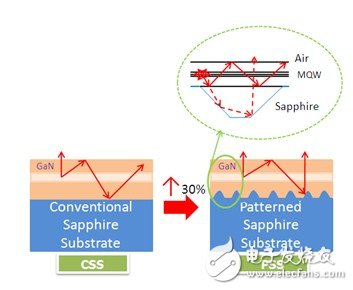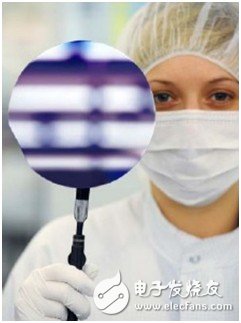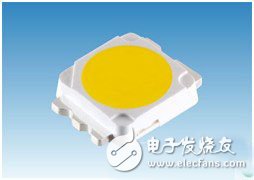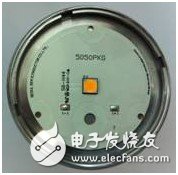OLED (Organic Light-emitTIng Diodes), the Chinese name is organic light-emitting diode, is a light-emitting diode based on organic semiconductor materials. OLED has many advantages such as full solid state, active light emission, high contrast, ultra-thin, low power consumption, no viewing angle limitation, fast response speed, wide operating temperature range, easy to achieve flexibility and large area, low power consumption and so on. At present, OLED has been applied in the field of small-size display such as mobile phone terminals, and the development potential in the field of large-size TVs and lighting has also been recognized by the industry. OLED has been regarded as one of the most promising display and lighting products in the 21st century.
The OLED is officially on the stage of lighting from 2012. Although it is only a small role at present, it has no small substitute threat to LED.
At the Frankfurt Fair in April, Philips showed the Lumiblade OLED GL350 panel with the latest OLED technology for the first time. Each GL 350 OLED panel measures approximately 155 square centimeters and has a brightness of 115LM.

On May 8-11, 2012, at the Las Vegas Lighting Show in the United States, Philips once again exhibited an OLED mirror product, which automatically senses the proximity of the human body and automatically models the surrounding OLED light source. The group makes adjustments, and the middle darkens into a mirror effect. Successfully integrated the concept of smart lamps and OLEDs.

As the leading brand in the global lighting market, Philips, betting on the meaning of OLED is very obvious.
However, OLED is used in the field of lighting, but the light effect is not a small test. In the display field, OLED brightness can be applied to 100 ~ 300cd / cm², but in lighting applications, the brightness must be at least 1000 ~ 3000cd / cm². In the next few years, the rate at which OLEDs and LEDs will trade in the lighting field will depend on the progress of OLED light efficiency catch-up.
Keyword 2: PSS
PSS (Patterned Sapphire Substrate), that is, growing a mask for dry etching on a sapphire substrate, using a standard photolithography process to pattern the mask, using ICP etching technology to etch sapphire, and removing the mask, Then grow GaN material on it, so that the longitudinal development of GaN material becomes lateral. On the one hand, it can effectively reduce the dislocation density of the GaN epitaxial material, thereby reducing the non-radiative recombination of the active region, improving the internal quantum efficiency, reducing the reverse leakage current, and improving the life of the LED; on the other hand, the The light is scattered multiple times through the interface of GaN and sapphire substrate, changing the exit angle of the total reflection light, increasing the probability of the light of the flip-chip LED exiting from the sapphire substrate, thereby improving the extraction efficiency of light.

As a result, PSS became the mainstream technology for improving the brightness of epitaxial manufacturers for a time, and it was rapidly popularized. By the second half of 2012, PSS had accounted for nearly 80% of the world's LED sapphire substrates.
In the first half of the year, the price of flat sapphire substrates fell, and substrate manufacturers generally suffered losses. Because of the strong market demand, the market price of PSS has exceeded 2 times of the flat film for a time, attracting sapphire substrate factories to increase their deployment, hoping to break through the dilemma of revenue loss. However, as the new production capacity is gradually put into use, the price of PSS drops at an alarming rate.

Some major manufacturers have considered adopting more advanced nPSS technology at this time. The pitch of nPSS is less than 1um, and the brightness can be increased by 3% to 10% compared to PSS. The cost of embossing is more than one dollar lower than that of etching, and the stability and consistency are also better. I am afraid that the substrate factories that rely on PSS to save the decline may be disappointed again, but who can guess the path of technological progress?
Keyword 3: Non-sapphire substrate
In addition to CREE's successful commercial SiC substrate, people have become accustomed to the substrate material is sapphire. However, in 2012, the non-sapphire substrate solution for the first time challenged the status of the sapphire substrate.
The most threatening challenge undoubtedly comes from the silicon substrate. On January 12, 2012, Osram promoted the successful growth of GaN epitaxy on a 150mm silicon wafer, cut into 1mm² and the brightness can reach 140lm at 350mA. The project is the German Federal Education And part of the "Gallium Nitride on Silicon" project funded by the Ministry of Research.
Toshiba's action is a step faster. In mid-December 2012, Toshiba, which did not dabble in packaging, directly sells LEDs, and the chips are based on LEDs grown on 8-inch silicon substrates in cooperation with Bridgelux of the United States. chip. Toshiba released a total of four current product specifications, including a color temperature 3000K, a color temperature 4000K and two color temperature 5000K LED products. Among them, when the typical forward voltage is 2.9V, 350mA drives a color temperature of 5000K, and the color rendering index is 70. The model is TL1F1-NW0 LED, and the light efficiency reaches 110lm / W.

Image source: OSRAM

Image source: TOSHIBA
After years of hard work in the field of silicon substrates, the Chinese manufacturer Jingneng Optoelectronics launched in 2012 the luminous efficiency of more than 120lm / W silicon-based high-power LED chip products, which is a great good news for domestic chips eager for independent intellectual property rights. .
In the results of the 2012 twelfth major information technology inventions selection in the information industry announced by the Ministry of Industry and Information Technology of China, the project "Gallium Nitride Silicone LED Materials and High Power Chip Technology on Silicon Substrate" of Jingneng Optoelectronics (Jiangxi) Co., Ltd. was rated as the information industry Major technological inventions, and incorporated into the "Electronic Information Industry Development Fund Project Guide", enjoy the national electronic information industry development fund project funding support.
The GaN-based homogeneous epitaxy is not weak. On July 3, 2012, Seoul Semiconductor released "npola" for the first time worldwide, with a single brightness of 500lm. Dr. Shunaka Nakamura made a special trip to Seoul to go to the conference platform. The SORAA company co-founded by Dr. Nakamura is a forward-looking GaN-on-GaN LED technology that has received funding from ARPA-E (Advanced Research Projects Agency-Energy), an energy conversion agency under the US DOE.
CREE has continuously launched a number of mass-produced LED products that refresh the industry's light efficiency under the so-called SC³ new-generation technology platform. In December, it also launched the XLamp series MK-R at 1W and 25 ° C, which can provide up to 200 lm / W luminous efficiency. Once again boost the overall strength of SiC substrate LED in the light efficiency competition.
The non-sapphire substrate solution is not only the common concern of the industry, but also governments of all countries have included it as an important basic research into the policy vision, and it is a matter of course to be selected in the top ten.

Source: Seoul Semiconductor

Source: Soraa
FGI `s Medium Voltage Drives take high-speed DSP as the control core, adopt space voltage vector control technology and power unit serial multi-level technology, and are designed with high reliability, easy operation and high performance to meet users` requirements of various load speed regulation, energy saving and production processes improvement. The Mv Drives` harmonic index is much smaller than the harmonic standard of IEEE 519-2014. The Medium Voltage VFD input power factor is high and the output waveform quality is good.
Medium Voltage Drives
Medium Voltage Drives,Medium Voltage Converter,High Voltage Converter,Medium Voltage Inverter,High Voltage Motor Driver,MV VFD Drives
FGI SCIENCE AND TECHNOLOGY CO., LTD , https://www.fgi-tech.com